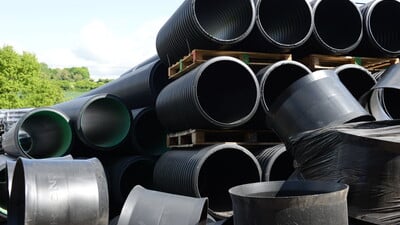General Purpose Ducting is a versatile, cost-effective solution for a wide range of underground cable and service protection needs. It’s available in multiple coil sizes and diameters, and it's widely used across the construction, utilities, and civil engineering sectors. But when is it the right ducting to choose?
To answer that, you first need to understand what General Purpose Ducting offers – and where its limitations lie.
What Is General Purpose Ducting?
General Purpose Ducting is usually a black, single-wall polyethylene duct supplied in flexible coils. It’s designed to provide basic protection for non-specified services – particularly where no particular colour-coding, mechanical strength, or specification standard (like ENATS or BT guidelines) is required.
You might find it listed in product descriptions as "flexible duct," "budget duct," or "non-specified cable duct." And that’s the key: it’s for non-specified applications – in other words, where regulations don’t demand a particular ducting material or colour.
Drainfast’s General Purpose Ducting, for example, is made to a high standard using durable polyethylene, and comes with a draw cord included for easy cable installation.
When Is General Purpose Ducting the Right Choice?
The main advantage of General Purpose Ducting is its versatility. It suits many applications where specific industry standards don’t apply – and it often proves more cost-effective and easier to handle than more specialised alternatives.
Private cable installations are a common example. If you're laying a cable from a house to an outbuilding, installing garden lighting, or routing a non-regulated CCTV or intercom line, General Purpose Ducting is typically a perfectly acceptable solution.
It’s also widely used in temporary works, where long-term durability and regulation compliance may be less critical. Site compounds, festival power installations, or temporary structures can all benefit from quick, affordable ducting.
Another area where General Purpose Ducting shines is in general landscaping or non-adopted infrastructure – areas that won’t be handed over to local authorities or utility companies and therefore don’t require colour-specific or ENATS-approved ductwork.
And if you’re simply protecting cables from mechanical damage underground – whether that’s due to soil movement, digging, or weather – and you’re not bound by a third-party specification, General Purpose Ducting can often do the job.
But Be Careful – It's Not Always Enough
It’s important to remember that General Purpose Ducting is not a catch-all solution. There are many situations where it’s not suitable – particularly where regulatory compliance, colour coding, or higher mechanical strength is needed.
For example, if you're installing a new gas service, you’ll need to use gas ducting, distinguishable by its bright yellow colour.
BT telecoms cables also require a colour coded ducting – this time, it’s grey – while TV cables must be protected by their characteristic green ducting.
Mains power cables, especially for adoption or in high-risk areas, you’ll need an ENATS-approved solution such as Rigiduct or Metropower.
Using the wrong duct in these cases could lead to delays, failed inspections, or costly reworks.
GP Ducting: A Cost-Effective Solution – When It’s the Right Fit
General Purpose Ducting exists to simplify projects that don’t need all the bells and whistles of more specialised ducting types. It’s easier to handle on site, comes in long coils to minimise jointing, and can often be laid quickly by a small team. For basic cable protection in a private or low-risk setting, it’s hard to beat.
We supply it in a wide range of diameters and coil lengths, all manufactured to a consistent, reliable standard. A built-in draw cord and smooth inner bore help to streamline cable insertion without excessive friction or snagging.
Know What You’re Doing – or Ask!
Like any product, General Purpose Ducting only works if it’s used correctly. Always check your project specifications, and if in doubt, Drainfast is just a phone call away on 01420 555600. Our team can help you navigate the full range of underground ducting options to find the best fit for your application.

Written by
Bob Stone
Technical Sales
Heading up our Technical Estimating Department, Bob is our in-house quantity surveyor.

